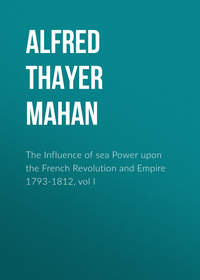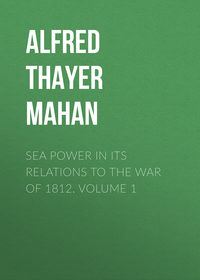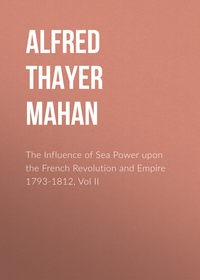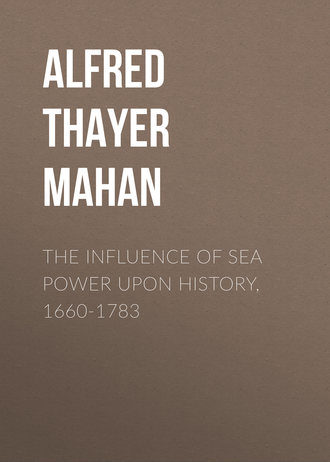 полная версия
полная версияThe Influence of Sea Power Upon History, 1660-1783
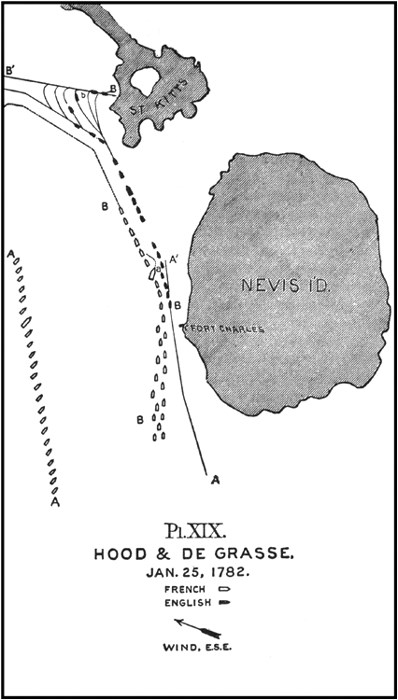
Pl. XIX.
The anchorage thus brilliantly taken by Hood was not exactly the same as that held by De Grasse the day before; but as it covered and controlled it, his claim that he took up the place the other had left is substantially correct. The following night and morning were spent in changing and strengthening the order, which was finally established as follows (Plate XVIII., B, B’). The van ship was anchored about four miles southeast from Basse Terre, so close to the shore that a ship could not pass inside her, nor, with the prevailing wind, even reach her, because of a point and shoal just outside, covering her position. From this point the line extended in a west-northwest direction to the twelfth or thirteenth ship (from a mile and a quarter to a mile and a half), where it turned gradually but rapidly to north, the last six ships being on a north and south line. Hood's flag-ship, the "Barfleur," of ninety guns, was at the apex of the salient angle thus formed.
It would not have been impossible for the French fleet to take the anchorage they formerly held; but it and all others to leeward were forbidden by the considerations already stated, so long as Hood remained where he was. It became necessary therefore to dislodge him, but this was rendered exceedingly difficult by the careful tactical dispositions that have been described. His left flank was covered by the shore. Any attempt to enfilade his front by passing along the other flank was met by the broadsides of the six or eight ships drawn up en potence to the rear. The front commanded the approaches to Basse Terre. To attack him in the rear, from the northwest, was forbidden by the trade-wind. To these difficulties was to be added that the attack must be made under sail against ships at anchor, to whom loss of spars would be of no immediate concern; and which, having springs196 out, could train their broadsides over a large area with great ease.
Nevertheless, both sound policy and mortification impelled De Grasse to fight, which he did the next day, January 26. The method of attack, in single column of twenty-nine ships against a line so carefully arranged, was faulty in the extreme; but it may be doubted whether any commander of that day would have broken through the traditional fighting order.197 Hood had intended the same, but he hoped a surprise on an ill-ordered enemy, and at the original French anchorage it was possible to reach their eastern ships, with but slight exposure to concentrated fire. Not so now. The French formed to the southward and steered for the eastern flank of Hood's line. As their van ship drew up with the point already mentioned, the wind headed her, so that she could only reach the third in the English order, the first four ships of which, using their springs, concentrated their guns upon her. This vessel was supposed by the English to be the "Pluton," and if so, her captain was D'Albert de Rions, in Suffren's opinion the foremost officer of the French navy. "The crash occasioned by their destructive broadsides," wrote an English officer who was present, "was so tremendous that whole pieces of plank were seen flying from her off side ere she could escape the cool, concentrated fire of her determined adversaries. As she proceeded along the British line, she received the first fire of every ship in passing. She was indeed in so shattered a state as to be compelled to bear away for St. Eustatius." And so ship after ship passed by, running the length of the line (Plate XVIII., B, B), distributing their successive fires in gallant but dreary, ineffectual monotony over the whole extent. A second time that day De Grasse attacked in the same order, but neglecting the English van, directed his effort upon the rear and centre. This was equally fruitless, and seems to have been done with little spirit.
From that time until the 14th of February, Hood maintained his position in sight of the French fleet, which remained cruising in the offing and to the southward. On the 1st a despatch vessel arrived from Kempenfeldt, informing him of the dispersal of the French reinforcements for the West Indies, which must have renewed his hopes that his bold attempt would be successful through Rodney's arrival. It was not, however, to be so. Brimstone Hill surrendered on the 12th, after a creditable defence. On the 13th De Grasse took his fleet, now amounting to thirty-three ships-of-the-line, to Nevis, and anchored there. On the night of the 14th Hood summoned all his captains on board, had them set their watches by his, and at eleven P.M., one after another, without noise or signal, cut their cables and made sail to the northward, passing round that end of the island unnoticed, or at least unmolested, by the French.
Both strategically and tactically Hood's conceptions and dispositions were excellent, and their execution was most honorable to the skill and steadiness of himself and his captains. Regarded as a single military operation, this was brilliant throughout; but when considered with reference to the general situation of England at the time, a much higher estimate must be formed of the admiral's qualities.198 St. Kitt's in itself might not be worth a great risk; but it was of the first importance that energy and audacity should be carried into the conduct of England's naval war, that some great success should light upon her flag. Material success was not obtained. The chances, though fair enough, turned against Hood; but every man in that fleet must have felt the glow of daring achievement, the assured confidence which follows a great deed nobly done. Had this man been in chief command when greater issues were at stake, had he been first instead of second at the Chesapeake, Cornwallis might have been saved. The operation—seizing an anchorage left by the enemy—would have been nearly the same; and both situations may be instructively compared with Suffren's relief of Cuddalore.
The action of De Grasse, also, should be considered not only with reference to the particular occasion, but to the general condition of the war as well, and when thus weighed, and further compared with other very similar opportunities neglected by this general officer, a fair estimate of his military capacity can be reached. This comparison, however, is better deferred to the now not very distant close of the campaign. The most useful comment to be made here is, that his action in failing to crush Hood at his anchors, with a force at least fifty per cent greater, was in strict accordance with the general French principle of subordinating the action of the fleet to so-called particular operations; for nothing is more instructive than to note how an unsound principle results in disastrous action. Hood's inferiority was such as to weaken, for offensive purposes, his commanding position. So long as De Grasse kept to windward, he maintained his communications with Martinique, and he was strong enough, too, to force communication when necessary with the troops before Brimstone Hill. It was probable, as the event showed, that the particular operation, the reduction of St. Kitt's, would succeed despite the presence of the English fleet; and "the French navy has always preferred the glory of assuring a conquest to that, more brilliant perhaps but less real, of taking a few ships."
So far De Grasse may be acquitted of any error beyond that of not rising above the traditions of his service. Some days, however, before the surrender of the island and the departure of the English fleet, he was joined by two ships-of-the-line which brought him word of the dispersal of the expected convoy and reinforcements from Europe.199 He then knew that he himself could not be strengthened before Rodney's arrival, and that by that event the English would be superior to him. He had actually thirty-three ships-of-the-line in hand, and a few miles off lay twenty-two English in a position where he knew they would await his attack; yet he let them escape. His own explanation implies clearly that he had no intention of attacking them at anchor:—
"The day after the capitulation of Brimstone Hill was the moment to watch Hood closely, and to fight him as soon as he got under way from the conquered island. But our provisions were exhausted; We had only enough for thirty-six hours. Some supply-ships had arrived at Nevis, and you will admit one must live before fighting. I went to Nevis, always to windward and in sight of the enemy, a league and a half from him, in order to take on board the necessary supplies as rapidly as possible. Hood decamped at night without signals, and the next morning I found only the sick whom he left behind."200
In other words, Hood having held his ground with consummate audacity and skill, when he had some chance of successful resistance, declined to await his adversary's attack under conditions overwhelmingly unfavorable. What shall be said of this talk about provisions? Did not the Comte de Grasse know a month before how long, to a day, the supplies on board would last? Did he not know, four days before Hood sailed, that he had with him every ship he could probably count on for the approaching campaign, while the English would surely be reinforced? And if the English position was as strong as good judgment, professional skill, and bold hearts could make it, had it not weak points? Were not the lee ships to leeward? If they did attempt to beat to windward, had he not ships to "contain" them? If the van ship could not be reached, had he not force enough to double and treble on the third and following ships, as far down the line as he chose? A letter of Suffren's, referring to a similar condition of things at Santa Lucia,201 but written three years before these events, seems almost a prophetic description of them:—
"Notwithstanding the slight results of the two cannonades of December 15 [1778], we can yet expect success; but the only way to attain it is to attack vigorously the squadron, which in consequence of our superiority cannot hold out, despite their land works, which will become of no effect if we lay them on board, or anchor upon their buoys. If we delay, a thousand circumstances may save them. They may profit by the night to depart."
There can be no doubt that the English would have sold their defeat dearly; but results in war must be paid for, and the best are in the long run the cheapest. A tight grip of a few simple principles—that the enemy's fleet was the controlling factor in the coming campaign, that it was therefore his true objective, that one fraction of it must be crushed without delay when caught thus separated—would have saved De Grasse a great blunder; but it is only fair to note that it would have made him an exception to the practice of the French navy.
The hour was now close at hand when the French admiral should feel, even if he did not admit, the consequences of this mistake, by which he had won a paltry island and lost an English fleet. Rodney had sailed from Europe on the 15th of January, with twelve ships-of-the-line. On the 19th of February he anchored at Barbadoes, and the same day Hood reached Antigua from St. Kitt's. On the 25th the squadrons of Rodney and Hood met to windward of Antigua, forming a united fleet of thirty-four ships-of-the-line. The next day De Grasse anchored in Fort Royal, thus escaping the pursuit which Rodney at once began. The English admiral then returned to Sta. Lucia, where he was joined by three more ships-of-the-line from England, raising his force to thirty-seven. Knowing that a large convoy was expected from France, before the arrival of which nothing could be attempted, Rodney sent a part of his fleet to cruise to windward and as far north as Guadeloupe; but the officer in charge of the French convoy, suspecting this action, kept well north of that island, and reached Fort Royal, Martinique, on the 20th of March. The ships-of-war with him raised De Grasse's fleet to thirty-three effective sail-of-the-line and two fifty-gun ships.
The object of the united efforts of France and Spain this year was the conquest of Jamaica. It was expected to unite at Cap Français (now Cap Haïtien), in Hayti, fifty ships-of-the-line and twenty thousand troops. Part of the latter were already at the rendezvous; and De Grasse, appointed to command the combined fleets, was to collect in Martinique all the available troops and supplies in the French islands, and convoy them to the rendezvous. It was this junction that Rodney was charged to prevent.
The region within which occurred the important operations of the next few days covers a distance of one hundred and fifty miles, from south to north, including the islands of Sta. Lucia, Martinique, Dominica, and Guadeloupe, in the order named. (See Plate XI. p. 378.) At this time the first was in English, the others in French, hands. The final, and for the moment decisive, encounter took place between, and a little to westward of, Dominica and Guadeloupe. These are twenty-three miles apart; but the channel is narrowed to thirteen by three islets called the Saints, lying ten miles south of Guadeloupe. It is said to have been De Grasse's intention, instead of sailing direct for Cap Français,202 to take a circuitous course near the islands, which, being friendly or neutral, would give refuge to the convoy if pressed. The close pursuit of the English, who came up with him off Dominica, led him to forsake this plan, sending the convoy into Basse Terre at the south end of Guadeloupe, while with the fleet he tried to beat through the channel and pass east of the island, thus drawing the English away from the transports and ridding himself of the tactical embarrassment due to the latter's presence. Accidents to various ships thwarted this attempt, and brought about a battle disastrous to him and fatal to the joint enterprise.
The anchorages of the two fleets, in Martinique and Sta. Lucia, were thirty miles apart. The prevailing east wind is generally fair to pass from one to the other; but a strong westerly current, and the frequency of calms and light airs, tend to throw to leeward sailing-ships leaving Sta. Lucia for the northern island. A chain of frigates connected the English lookout ships off Martinique, by signal, with Rodney's flag-ship in Gros Ilot Bay. Everything was astir at the two stations, the French busy with the multitudinous arrangements necessitated by a great military undertaking, the English with less to do, yet maintaining themselves in a state of expectancy and preparation for instant action, that entails constant alertness and mental activity.
On the 5th of April Rodney was informed that the soldiers were being embarked, and on the 8th, soon after daylight, the lookout frigates were seen making signal that the enemy was leaving port. The English fleet at once began to get under way, and by noon was clear of the harbor to the number of thirty-six of the line. At half-past two P.M. the advanced frigates were in sight of the French fleet, which was seen from the mastheads of the main body just before sundown. The English stood to the northward all night, and at daybreak of the 9th were abreast Dominica, but for the most part becalmed. In-shore of them, to the northward and eastward, were seen the French fleet and convoy: the men-of-war numbering thirty-three of the line, besides smaller vessels; the convoy a hundred and fifty sail, under special charge of the two fifty-gun ships. The irregular and uncertain winds, common to the night and early hours of the day near the land, had scattered these unwieldy numbers. Fifteen sail-of-the-line were in the channel between Dominica and the Saints, with a fresh trade-wind, apparently beating to windward; the remainder of the ships-of-war and most of the convoy were still becalmed close under Dominica (Plate XX., Position I, b). Gradually, however, one by one, the French ships were catching light airs off the land; and by favor of these, which did not reach so far as the English in the offing, drew out from the island and entered the more steady breeze of the channel, reinforcing the group which was thus possessed of that prime element of naval power, mobility. At the same time light airs from the southeast crept out to the English van under Hood, fanning it gently north from the main body of the fleet toward two isolated French ships (i), which, having fallen to leeward during the night, had shared the calms that left the English motionless, with their heads all round the compass. They had come nearly within gunshot, when a light puff from the northwest enabled the Frenchmen to draw away and approach their own ships in the channel.
The farther the English van advanced, the fresher grew their wind, until they fairly opened the channel of the Saints and felt the trade-wind. De Grasse signalled to the convoy to put into Guadeloupe, which order was so well carried out that they were all out of sight to the northward by two in the afternoon, and will appear no more in the sequel. The two French ships, already spoken of as fallen to leeward, not being yet out of danger from the English van, which had now a commanding breeze, and the latter being much separated from their rear and centre, De Grasse ordered his van to bear down and engage. This was obeyed by the ships signalled and by three others, in all by fourteen or fifteen, the action beginning at half-past nine A.M., and lasting with intermissions until quarter-past one P.M. Hood was soon forced to heave-to, in order not to increase too much his separation from the main fleet; the French kept under way, approaching from the rear and passing in succession at half cannon-shot to windward (Plate XX., Position I.). As each ship drew ahead of the English division, she tacked, standing back to the southward until in position to resume her place in the order of attack, thus describing a continuous irregular curve of elliptical form, to windward of their opponents. The brunt of the attack fell upon eight or nine of the English, this number being successively increased as one ship after another, as the baffling airs served, drew out from the calm space under Dominica; but the French received similar accessions. While this engagement was going on, part of the English centre, eight ships with Rodney's flag among them (Position I., a), by carefully watching the puffs and cat's-paws, had worked in with the land and caught the sea breeze, which was felt there sooner than in the offing. As soon as they had it, about eleven A.M., they stood to the north, being now on the weather quarter203 both of the English van and its assailants (Position II., a). The latter, seeing this, tacked, and abandoning the contest for the moment, steered south to join their centre, lest Rodney's eight ships should get between them. At half-past eleven the French again formed line on the starboard tack, most of their ships being now clear of the land, while the English rear was still becalmed. The greater numbers of the French enabled them to extend from north to south along the length of the English line, whereas the latter was still broken by a great gap between the van and centre (Position II.). The attack upon Hood was therefore hotly renewed; but the French centre and rear (b), having the wind, kept their distance, and held Rodney's division at long range. At quarter-past one the French, finding that the whole British line was coming up with the wind, ceased firing, and at two Rodney hauled down the signal for battle, the enemy having withdrawn.

Pl. XX.
This action of the 9th of April amounted actually to no more than an artillery duel. One French ship, the "Caton," a sixty-four (d), received injuries which sent her into Guadeloupe; two English were disabled, but repaired their injuries without leaving the fleet. The material advantage, therefore, lay with the latter. Opinions differ as to the generalship of the Comte de Grasse on this day, but they divide on the same basis of principle as to whether ulterior operations, or the chances of beating the enemy's fleet, are to determine an admiral's action. The facts of the case are these: Sixteen of the English fleet, all the rear and four of the centre (Position II., c), were not able at any time to fire a shot. Apparently every French ship, first and last, might have been brought into action. At the beginning, eight or nine English were opposed to fifteen French. At the end there were twenty English to thirty-three French, and these general proportions doubtless obtained throughout the four hours. De Grasse therefore found himself in the presence of a fleet superior to his own, in numbers at least, and by the favor of Providence that fleet so divided that nearly half of it was powerless to act. He had the wind, he had a fine body of captains; what was to prevent him from attacking Hood's nine ships with fifteen, putting one on each side of the six in the rear. Had those nine been thoroughly beaten, Rodney's further movements must have been hopelessly crippled. The French lost only five in their defeat three days later. The subsequent court-martial, however, laid down the French doctrine thus: "The decision to persist in engaging with only a part of our fleet may be considered as an act of prudence on the part of the admiral, which might be dictated by the ulterior projects of the campaign." On this a French professional writer naturally remarks, that if an attack were made at all, it would be more prudent to make it in force; less injury would fall on individual ships, while in the end the whole fleet would inevitably be drawn in to support any which, by losing spars, could not return to windward.
Three times in one year had Fortune thrown before De Grasse the opportunity of attacking English fleets with decisive odds on his side.204 Her favors were now exhausted. Three days more were to show how decidedly the ulterior projects of a campaign may be affected by a battle and the loss of a few ships. From the 9th to the morning of the 12th the French fleet continued beating to windward between Dominica and the Saints, in no regular order. On the night of the 9th the English hove-to to repair damages. The next day the chase to windward was resumed, but the French gained very decidedly upon their pursuers. On the night of the 10th two ships, the "Jason" and "Zélé," collided. The "Zélé" was the bane of the French fleet during these days. She was one of those that were nearly caught by the enemy on the 9th, and was also the cause of the final disaster. The injuries to the "Jason" forced her to put into Guadeloupe. On the 11th the main body was to windward of the Saints, but the "Zélé" and another had fallen so far to leeward that De Grasse bore down to cover them, thus losing much of the ground gained. On the night following, the "Zélé" was again in collision, this time with De Grasse's flag-ship; the latter lost some sails, but the other, which had not the right of way and was wholly at fault, carried away both foremast and bowsprit. The admiral sent word to the frigate "Astrée" to take the "Zélé" in tow; and here flits across the page of our story a celebrated and tragical figure, for the captain of the "Astrée" was the ill-fated explorer Lapeyrouse, the mystery of whose disappearance with two ships and their entire crews remained so long unsolved. Two hours were consumed in getting the ship under way in tow of the frigate,—not very smart work under the conditions of weather and urgency; but by five A.M. the two were standing away for Basse Terre, where the "Caton" and "Jason," as well as the convoy, had already arrived. The French fleet had thus lost three from its line-of-battle since leaving Martinique.
The disabled ship had not long been headed for Basse Terre, when the faint streaks of dawn announced the approach of the 12th of April, a day doubly celebrated in naval annals. The sun had not quite set upon the exhausted squadrons of Suffren and Hughes, anchoring after their fiercest battle off Ceylon, when his early rays shone upon the opening strife between Rodney and De Grasse.205 The latter was at the time the greatest naval battle in its results that had been fought in a century; its influence on the course of events was very great, though far from as decisive as it might have been; it was attended with circumstances of unusual though somewhat factitious brilliancy, and particularly was marked by a manœuvre that was then looked upon as exceptionally daring and decisive,—"breaking the line." It must be added that it has given rise to a storm of controversy; and the mass of details, as given by witnesses who should be reliable, are so confused and contradictory, owing mainly to the uncertainties of the wind, that it is impossible now to do more than attempt to reconcile them in a full account. Nevertheless, the leading features can be presented with sufficient accuracy, and this will first be done briefly and barely; the outline thus presented can afterward be clothed with the details which give color, life, and interest to the great scene.





